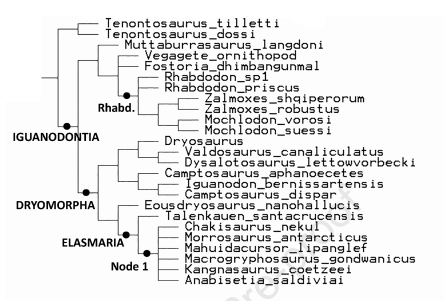MEANING: Elder guanaco lizard
PERIOD: Late Cretaceous
CONTINENT: South America
Chakisaurus is a medium-sized elasmarian ornithopod dinosaur from the Late Cretaceous of what is now Argentina. The genus is known from multiple partial skeletons belonging to individuals of different ages. Elasmaria is a diverse group of basal ornithopods known from the southern hemisphere. Chakisaurus is notable for having a downward curve in the base of its tail, a trait previously only seen in titanosaurs.

Abstract from paper: The aim of the present contribution is to describe the first ornithischian species from the Huincul Formation (Cenomanian-Turonian, Upper Cretaceous) at the Pueblo Blanco Natural Reserve, Río Negro province, Argentina. The new species, named as Chakisaurus nekul gen. et sp. nov., can be comfortably included among elasmarian ornithopods. The new species shows humeral anatomy that is congruent with smaller members of the clade (e.g. Anabisetia, Notohypsilophodon), and differs from larger taxa (e.g. Talenkauen, Mahuidacursor) which show humeral features probably related with graviportal habits, such as lack of shaft torsion and a distally located deltopectoral crest. This indicates that graviportal habits were probably acquired independently in elasmarians from other large-sized taxa, such as hadrosauroids. Caudal vertebrae of the new species also show a unique combination of characters shared with other elasmarians, which are absent in previously known ornithopods. These features indicate that some elasmarians had a protonic tail posture, which is unknown in other ornithischians and which was previously considered as unique to derived titanosaurian sauropods. The shape of transverse processes and neural spines of caudal vertebrae indicate that at least some elasmarians had improved cursorial habilities, that were convergently acquired by selected theropod clades.
Chakisaurus is from the Cretaceous. The Cretaceous is a geological period that lasted from about 145 to 66 million years ago. It is the third and final period of the Mesozoic Era, as well as the longest. At around 79 million years, it is the longest geological period of the entire Phanerozoic. The name is derived from the Latin creta, "chalk", which is abundant in the latter half of the period.
The Cretaceous was a period with a relatively warm climate, resulting in high eustatic sea levels that created numerous shallow inland seas. These oceans and seas were populated with now-extinct flora and fauna, while dinosaurs continued to dominate on land. The world was ice free, and forests extended to the poles. During this time, new groups of mammals and birds appeared. During the Early Cretaceous, flowering plants appeared and began to rapidly diversify, becoming the dominant group of plants across the Earth by the end of the Cretaceous, coincident with the decline and extinction of previously widespread gymnosperm groups.
The Cretaceous (along with the Mesozoic) ended with the Cretaceous–Paleogene extinction event, a large mass extinction in which many groups, including non-avian dinosaurs, pterosaurs, and large marine reptiles, died out. The end of the Cretaceous is defined by the abrupt Cretaceous–Paleogene boundary (K–Pg boundary), a geologic signature associated with the mass extinction that lies between the Mesozoic and Cenozoic Eras.
Chakisaurus is an ornithopod. Ornithopoda is a clade of ornithischian dinosaurs that started out as small, bipedal running grazers and grew in size and numbers until they became one of the most successful groups of herbivores in the Cretaceous. They dominated the North American continent, then spread to Asia and eventually the southern hemisphere toward the end of the Cretaceous. Their major evolutionary advantage was their batteries of teeth, which allowed them to process vegetation in an extremely efficient way. Ornithopods were a diverse group, and included the hadrosaurs, which continued to dominate until the Cretaceous–Paleogene extinction event, which wiped out all non-avian dinosaurs.









